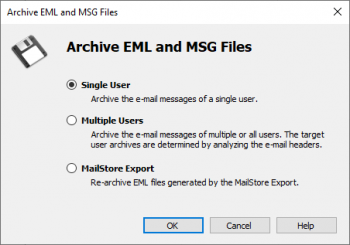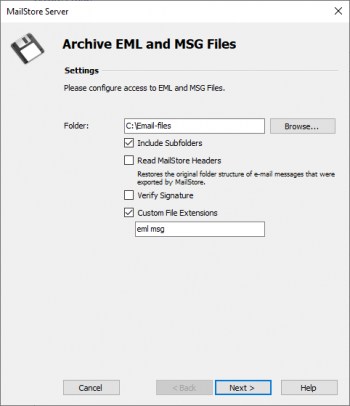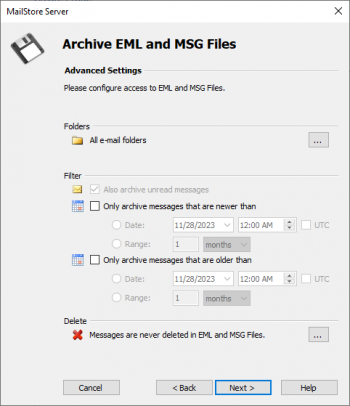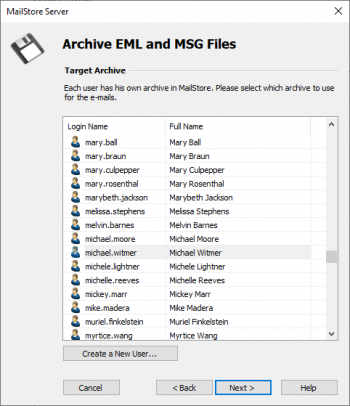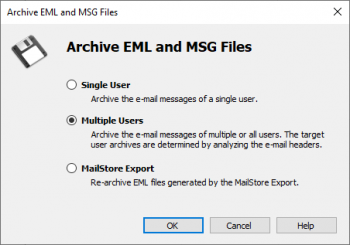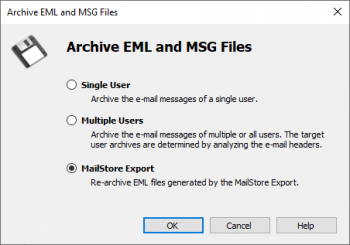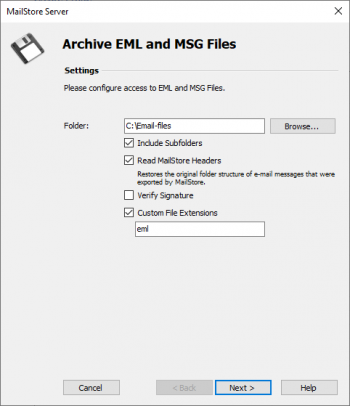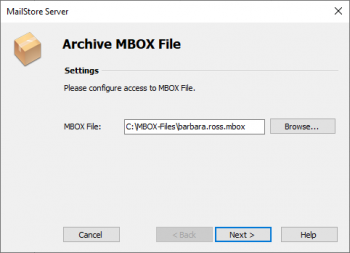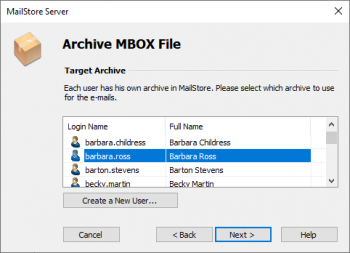Difference between revisions of "Archiving Emails from External Systems - File Import"
| [unchecked revision] | [checked revision] |
| (6 intermediate revisions by 2 users not shown) | |||
| Line 1: | Line 1: | ||
| − | |||
| − | |||
| − | |||
| − | |||
MailStore Server can also archive the emails from applications that are not directly supported if they are available in a standardized format. With most applications it is necessary to export the emails to one of those formats first. | MailStore Server can also archive the emails from applications that are not directly supported if they are available in a standardized format. With most applications it is necessary to export the emails to one of those formats first. | ||
| Line 12: | Line 8: | ||
*'''MBOX''' - This file format is used by Mozilla Thunderbird, for example, although in this case the file ending is omitted. The MBOX file format is also used by many Unix mail servers. | *'''MBOX''' - This file format is used by Mozilla Thunderbird, for example, although in this case the file ending is omitted. The MBOX file format is also used by many Unix mail servers. | ||
| − | = Procedure for Archiving PST Files = | + | == Procedure for Archiving PST Files == |
| − | |||
Archiving PST files is described separately in chapter [[Archiving_Outlook_PST_Files_Directly|Archiving Outlook PST Files Directly]]. | Archiving PST files is described separately in chapter [[Archiving_Outlook_PST_Files_Directly|Archiving Outlook PST Files Directly]]. | ||
| − | = Procedure for Archiving EML and MSG Files = | + | == Procedure for Archiving EML and MSG Files == |
| − | |||
Setting up archiving processes for files from the file system is done using archiving profiles. General information about archiving profiles is available in chapter [[Email_Archiving_with_MailStore_Basics#Working_with_Archiving_Profiles|Working with Archiving Profiles]]. | Setting up archiving processes for files from the file system is done using archiving profiles. General information about archiving profiles is available in chapter [[Email_Archiving_with_MailStore_Basics#Working_with_Archiving_Profiles|Working with Archiving Profiles]]. | ||
| − | == Archiving Emails of a Single User == | + | === Archiving Emails of a Single User === |
| − | + | <p class="msnote">'''Please note:''' If you do not want to archive email files in your personal user archive only, you'll have to be logged on to MailStore Client as a MailStore Server administrator. Only a MailStore Server administrator can archive emails for other users.</p> | |
| − | <p class="msnote">''' | ||
Please proceed as follows: | Please proceed as follows: | ||
| Line 44: | Line 37: | ||
*In the final step you can specify a name for the new archiving profile. After clicking on ''Finish'', the archiving profile will be listed under ''Saved Profiles'' and can be run immediately, if desired. | *In the final step you can specify a name for the new archiving profile. After clicking on ''Finish'', the archiving profile will be listed under ''Saved Profiles'' and can be run immediately, if desired. | ||
| − | == Archiving Emails of Multiple Users == | + | === Archiving Emails of Multiple Users === |
| − | + | <p class="msnote">'''Please note:''' In order to be able to select this archiving method, you'll have to be logged on to MailStore Client as a MailStore Server administrator. Only a MailStore Server administrator can archive emails for other users.</p> | |
| − | <p class="msnote">''' | ||
In addition to archiving email files of a single user, MailStore Server can archive email files of multiple users from a single directory; such emails may have been exported from a multidrop mailbox.<br/> | In addition to archiving email files of a single user, MailStore Server can archive email files of multiple users from a single directory; such emails may have been exported from a multidrop mailbox.<br/> | ||
| Line 56: | Line 48: | ||
*: [[File:arch_filesystem_04.png|center|350px]] | *: [[File:arch_filesystem_04.png|center|350px]] | ||
* Select ''Multiple Users'' and click on ''OK''. | * Select ''Multiple Users'' and click on ''OK''. | ||
| + | *: {{Archiving_Multiple_or_Multidrop_Note|from a source that contains emails of multiple users}} | ||
* The dialog window ''Archive Multidrop Mailbox (Filesystem)'' appears. | * The dialog window ''Archive Multidrop Mailbox (Filesystem)'' appears. | ||
*: [[File:arch_filesystem_05.png|center|350px]] | *: [[File:arch_filesystem_05.png|center|350px]] | ||
| Line 63: | Line 56: | ||
* In the final step you can specify a name for the new archiving profile. After clicking on ''Finish'', the archiving profile will be listed under ''Saved Profiles'' and can be run immediately, if desired. | * In the final step you can specify a name for the new archiving profile. After clicking on ''Finish'', the archiving profile will be listed under ''Saved Profiles'' and can be run immediately, if desired. | ||
| − | == Archiving Emails from a MailStore Export == | + | === Archiving Emails from a MailStore Export === |
| − | + | <p class="msnote">'''Please note:''' In order to be able to select this archiving method, you'll have to be logged on to MailStore Client as a MailStore Server administrator. Only a MailStore Server administrator can archive emails for other users.</p> | |
| − | <p class="msnote">''' | ||
To archive EML files which have been created by a MailStore Export, the correct options have been pre-selected. This provides an easy way to file emails exported from MailStore Server into the correct user archives and folders again.<br/> | To archive EML files which have been created by a MailStore Export, the correct options have been pre-selected. This provides an easy way to file emails exported from MailStore Server into the correct user archives and folders again.<br/> | ||
| Line 78: | Line 70: | ||
*: [[File:arch_filesystem_07.png|center|350px]] | *: [[File:arch_filesystem_07.png|center|350px]] | ||
*Select the folder to be archived. All email files in this folder will be archived. | *Select the folder to be archived. All email files in this folder will be archived. | ||
| − | *If desired, adjust the advanced settings or simply click ''Next''. | + | *If desired, adjust the advanced settings or simply click ''Next''. |
| − | :*'''Include Subfolders:'''<br/>In addition to the emails in the selected folder also those located in any subfolders will be archived. | + | :*'''Include Subfolders:'''<br/>In addition to the emails in the selected folder also those located in any subfolders will be archived. |
| − | :*'''Read MailStore Headers:'''<br/>RFC 822 (EML) files created by the MailStore Server-specific export process contain additional information about the source archives and folders. This information allows to file emails exported from MailStore Server into the correct user archives and folders when being rearchived. Non-existent archives and folders will be created automatically. | + | :*'''Read MailStore Headers:'''<br/>RFC 822 (EML) files created by the MailStore Server-specific export process contain additional information about the source archives and folders. This information allows to file emails exported from MailStore Server into the correct user archives and folders when being rearchived. Non-existent archives and folders will be created automatically. |
| − | :* '''Custom File Extensions:'''<br/>Here you can make appropriate entries if the files to be archived are in EML or MSG format but have a different file extension. | + | :*'''Custom File Extensions:'''<br/>Here you can make appropriate entries if the files to be archived are in EML or MSG format but have a different file extension. |
*If needed, adjust the settings for the [[Email_Archiving_with_MailStore_Basics#Archiving_Specific_Folders|List of Folders to be Archived]], the filter and the [[Email_Archiving_with_MailStore_Basics#Archiving_Specific_Folders|Deletion Rules]]. | *If needed, adjust the settings for the [[Email_Archiving_with_MailStore_Basics#Archiving_Specific_Folders|List of Folders to be Archived]], the filter and the [[Email_Archiving_with_MailStore_Basics#Archiving_Specific_Folders|Deletion Rules]]. | ||
*:[[File:arch_filesystem_02.png|center|350px]] | *:[[File:arch_filesystem_02.png|center|350px]] | ||
| Line 88: | Line 80: | ||
*In the final step you can specify a name for the new archiving profile. After clicking on ''Finish'', the archiving profile will be listed under ''Saved Profiles'' and can be run immediately, if desired. | *In the final step you can specify a name for the new archiving profile. After clicking on ''Finish'', the archiving profile will be listed under ''Saved Profiles'' and can be run immediately, if desired. | ||
| − | = Procedure for Archiving MBOX Files = | + | == Procedure for Archiving MBOX Files == |
| − | |||
Setting up the archiving process for files from the file system is done using archiving profiles. General information about archiving profiles is available in chapter [[Email_Archiving_with_MailStore_Basics#Working_with_Archiving_Profiles|Working with Archiving Profiles]]. | Setting up the archiving process for files from the file system is done using archiving profiles. General information about archiving profiles is available in chapter [[Email_Archiving_with_MailStore_Basics#Working_with_Archiving_Profiles|Working with Archiving Profiles]]. | ||
| − | <p class="msnote">''' | + | <p class="msnote">'''Please note:''' If you do not want to archive email files in your personal user archive only, you'll have to be logged on to MailStore Client as a MailStore Server administrator. Only a MailStore Server administrator can archive emails for other users.</p> |
Please proceed as follows: | Please proceed as follows: | ||
| Line 105: | Line 96: | ||
* In the final step you can specify a name for the new archiving profile. After clicking on ''Finish'', the archiving profile will be listed under ''Saved Profiles'' and can be run immediately, if desired. | * In the final step you can specify a name for the new archiving profile. After clicking on ''Finish'', the archiving profile will be listed under ''Saved Profiles'' and can be run immediately, if desired. | ||
| − | = Archiving with Drag & Drop = | + | == Archiving with Drag & Drop == |
Files can also be archived using Drag & Drop: Simply drag the appropriate folder containing EML files or the appropriate MBOX file into the list of saved settings to create an archiving profile for this process directly. | Files can also be archived using Drag & Drop: Simply drag the appropriate folder containing EML files or the appropriate MBOX file into the list of saved settings to create an archiving profile for this process directly. | ||
| − | {{ | + | {{Starting the Archiving Process}} |
[[de:E-Mails_aus_Fremdsystemen_archivieren_(Dateiimport)]] | [[de:E-Mails_aus_Fremdsystemen_archivieren_(Dateiimport)]] | ||
| + | [[en:Archiving Emails from External Systems (File Import)]] | ||
Revision as of 13:56, 11 December 2019
MailStore Server can also archive the emails from applications that are not directly supported if they are available in a standardized format. With most applications it is necessary to export the emails to one of those formats first.
Using file import, MailStore Server can archive the following formats:
- EML - One file per email. Often called RFC 822 or MIME format.
- MSG - One file per email. Microsoft Outlook email files.
- PST - Microsoft Outlook personal folder files.
- MBOX - This file format is used by Mozilla Thunderbird, for example, although in this case the file ending is omitted. The MBOX file format is also used by many Unix mail servers.
Procedure for Archiving PST Files
Archiving PST files is described separately in chapter Archiving Outlook PST Files Directly.
Procedure for Archiving EML and MSG Files
Setting up archiving processes for files from the file system is done using archiving profiles. General information about archiving profiles is available in chapter Working with Archiving Profiles.
Archiving Emails of a Single User
Please note: If you do not want to archive email files in your personal user archive only, you'll have to be logged on to MailStore Client as a MailStore Server administrator. Only a MailStore Server administrator can archive emails for other users.
Please proceed as follows:
- In MailStore Server, click on Archive Email.
- From the E-mail Files category in the Create Profile section select EML and MSG files.
- A wizard opens, guiding you through the setup process.
- Select Single User and click on OK.
- The dialog window Archive EML and MSG files appears.
- Select the folder to be archived. All email files in this folder will be archived.
- If desired, adjust the advanced settings or simply click Next.
- Include Subfolders:
In addition to the emails in the selected folder also those located in any subfolders will be archived. - Read MailStore Headers:
RFC 822 files created by the MailStore Server-specific export process contain additional information such as the source folder. Set the checkmark if this information should be taken into account. - Custom File Extensions:
Here you can make appropriate entries if the files to be archived are in EML or MSG format but have a different file extension.
- Include Subfolders:
- If needed, adjust the settings for the List of Folders to be Archived, the filter and the Deletion Rules.
- If logged on to MailStore Server as a MailStore Server-administrator, the target archive can be specified in the next step of the wizard. Select the archive of the user for whom the selected files are to be archived.
- In the final step you can specify a name for the new archiving profile. After clicking on Finish, the archiving profile will be listed under Saved Profiles and can be run immediately, if desired.
Archiving Emails of Multiple Users
Please note: In order to be able to select this archiving method, you'll have to be logged on to MailStore Client as a MailStore Server administrator. Only a MailStore Server administrator can archive emails for other users.
In addition to archiving email files of a single user, MailStore Server can archive email files of multiple users from a single directory; such emails may have been exported from a multidrop mailbox.
To archive such emails please proceed as follows:
- In MailStore Server, click on Archive Email.
- From the E-mail Files category in the Create Profile section select EML and MSG files.
- A wizard opens, guiding you through the setup process.
- Select Multiple Users and click on OK.
- Please note: To be able to archive from a source that contains emails of multiple users, MailStore Server users along with their email addresses must exist in the MailStore Server user management. If this is not the case, MailStore Server will offer to set up and run the directory synchronization at this point. Once completed, the wizard will resume.
Alternatively, you can cancel the wizard and create users manually as described the in chapter User Management.
- Please note: To be able to archive from a source that contains emails of multiple users, MailStore Server users along with their email addresses must exist in the MailStore Server user management. If this is not the case, MailStore Server will offer to set up and run the directory synchronization at this point. Once completed, the wizard will resume.
- The dialog window Archive Multidrop Mailbox (Filesystem) appears.
- Select the folder with the email files to be archived.
- Adjust any further settings such as how to handle emails with unknown addresses or asking MailStore Server to delete email files after they have been archived.
- Click on Next.
- In the final step you can specify a name for the new archiving profile. After clicking on Finish, the archiving profile will be listed under Saved Profiles and can be run immediately, if desired.
Archiving Emails from a MailStore Export
Please note: In order to be able to select this archiving method, you'll have to be logged on to MailStore Client as a MailStore Server administrator. Only a MailStore Server administrator can archive emails for other users.
To archive EML files which have been created by a MailStore Export, the correct options have been pre-selected. This provides an easy way to file emails exported from MailStore Server into the correct user archives and folders again.
Please proceed as follows:
- In MailStore Server, click on Archive Email.
- From the E-mail Files category in the Create Profile section select EML and MSG files.
- A wizard opens, guiding you through the setup process.
- Select MailStore Export and click on OK.
- The dialog window Archive EML and MSG files appears.
- Select the folder to be archived. All email files in this folder will be archived.
- If desired, adjust the advanced settings or simply click Next.
- Include Subfolders:
In addition to the emails in the selected folder also those located in any subfolders will be archived. - Read MailStore Headers:
RFC 822 (EML) files created by the MailStore Server-specific export process contain additional information about the source archives and folders. This information allows to file emails exported from MailStore Server into the correct user archives and folders when being rearchived. Non-existent archives and folders will be created automatically. - Custom File Extensions:
Here you can make appropriate entries if the files to be archived are in EML or MSG format but have a different file extension.
- Include Subfolders:
- If needed, adjust the settings for the List of Folders to be Archived, the filter and the Deletion Rules.
- You can specify the target archive in the next step of the wizard. Select the archive of the user for whom the selected files are to be archived. The target archive will be ignored if the option Read MailStore Headers has been selected and the email to be archived contains such headers.
- In the final step you can specify a name for the new archiving profile. After clicking on Finish, the archiving profile will be listed under Saved Profiles and can be run immediately, if desired.
Procedure for Archiving MBOX Files
Setting up the archiving process for files from the file system is done using archiving profiles. General information about archiving profiles is available in chapter Working with Archiving Profiles.
Please note: If you do not want to archive email files in your personal user archive only, you'll have to be logged on to MailStore Client as a MailStore Server administrator. Only a MailStore Server administrator can archive emails for other users.
Please proceed as follows:
- In MailStore Server, click on Archive Email.
- From the Email Files list in the Create Profile area of the application window select MBOX File.
- A wizard opens, guiding you through the setup process.
- Select the MBOX file to be archived.
- If logged on to MailStore Server as administrator, the target archive can be specified. Select the archive of the user for whom the selected file is to be archived.
- In the final step you can specify a name for the new archiving profile. After clicking on Finish, the archiving profile will be listed under Saved Profiles and can be run immediately, if desired.
Archiving with Drag & Drop
Files can also be archived using Drag & Drop: Simply drag the appropriate folder containing EML files or the appropriate MBOX file into the list of saved settings to create an archiving profile for this process directly.
Starting the Archiving Process
Starting the Archiving Process Manually
On the start page of MailStore Client, click on Archive Email and from the list under Saved Profiles, select the appropriate archiving profile. Click on Run. After the archiving process has been executed, a protocol appears. It contains information about the volume of emails that have been archived as well as any errors that may have occurred.
This process can be repeated by the user any number of times. MailStore only archives those emails that are not yet stored in the corresponding user archive.
Automating the Archiving Process
In addition to being executed manually, archiving tasks can also be executed automatically. Additional information about this topic is available in chapter Automating the Archiving Process.
